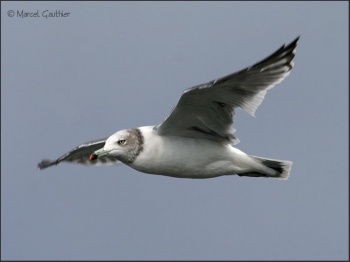
Photo © by Joseph Morlan
Aoiumi Park, Aomori Port, Aomori Prefecture, Japan, 6 May 2017
- Larus crassirostris
Identification
46-48 cm (18-19 in)
Adult breeding:
- White head, neck, breast, and underparts
- Pale charcoal-grey wings and back
- Large yellow bill with black ring above red tip
- Pale yellow eyes with red orbital ring
- Short yellow legs and feet
- Long wings
- Short white-edged black tail
Sexes are alike, although females average slightly smaller. Nonbreeding plumage similar but has dusky smudging on its head often forming a dark collar. They take three or four years to reach full adult plumage. Juveniles are dark chocolate brown with a white belly, long thin pink bill with a dark tip and broken pale eyering. First cycle birds have a mostly white body wand face with gray smudging on the sides, flanks and nape and mottled mantle contrasting with retained juvenile wing-coverts. Bill is like juvenile. Wing tips are solid black. Second cycle birds have body all white and mantle dark gray as adult, but wing coverts are mixture of scaly brownish and gray. Nape is smudged gray. Wing-tips solid black. Bill has small red tip. Third cycle is difficult to detect because it is so similar to the adult. The main differences are said to be a brownish tinge to the wing coverts, duller yellow legs and smaller white primary tips in unworn plumage. The differences are subtle and it remains unclear whether all individuals have a recognizable 3rd cycle plumage.
Distribution
Eastern Asia including China, Korea and Japan. Accidental to casual vagrant in the eastern United States; accidental to pacific states and to few interior states.
Taxonomy
This is a monotypic species[1].
Habitat
Coasts, bays and estuaries; breeds on sandy or rocky seashores, sea cliffs, and rocky islets.
Behaviour
It follows ships and trawlers and will steal food from other seabirds.
Diet
The diet includes small fish, molluscs, crustaceans and offal.
Breeding
A colonial nester, breeding starts in mid-April. The clutch consists of 2-3 eggs which are laid early June. Incubation lasts approximately 24 days.
Movements
Post-breeding dispersal to areas rich in food.
Vocalisations
A deep mewing kaoo kaoo, or yark yark yark. Also a plaintive rasping mewing.
References
- Clements, J. F., P. C. Rasmussen, T. S. Schulenberg, M. J. Iliff, T. A. Fredericks, J. A. Gerbracht, D. Lepage, A. Spencer, S. M. Billerman, B. L. Sullivan, and C. L. Wood. 2023. The eBird/Clements checklist of Birds of the World: v2023. Downloaded from https://www.birds.cornell.edu/clementschecklist/download/
- What Bird
- Wikipedia contributors. (2019, February 2). Black-tailed gull. In Wikipedia, The Free Encyclopedia. Retrieved 09:07, February 4, 2019, from https://en.wikipedia.org/w/index.php?title=Black-tailed_gull&oldid=881449086
- Burger, J., Gochfeld, M., Kirwan, G.M. & Garcia, E.F.J. (2017). Black-tailed Gull (Larus crassirostris). In: del Hoyo, J., Elliott, A., Sargatal, J., Christie, D.A. & de Juana, E. (eds.). Handbook of the Birds of the World Alive. Lynx Edicions, Barcelona. (retrieved from http://www.hbw.com/node/53965 on 9 June 2017).
- Howell, S.N.G. & Dunn, J.L. (2007) Gulls of the Americas. Houghton Mifflin, Boston.
- Howell, S.N.G., Lewington, I. & Russell, W. (2014) Rare Birds of North America. Princeton Univ. Press
- Lethaby, N. & Bangma, J. (1998). Identifying Black-tailed Gull in North America. Birding 30 (6): 470-483.
Recommended Citation
- BirdForum Opus contributors. (2025) Black-tailed Gull. In: BirdForum, the forum for wild birds and birding. Retrieved 12 May 2025 from https://www.birdforum.net/opus/Black-tailed_Gull
External Links
GSearch checked for 2020 platform.1






